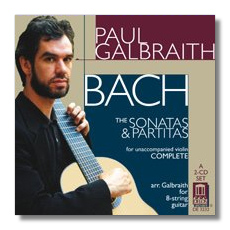
The Internet's Premier Classical Music Source
Related Links
- J.S. Bach Reviews
- Latest Reviews
- More Reviews
-
By Composer
-
Collections
DVD & Blu-ray
Books
Concert Reviews
Articles/Interviews
Software
Audio
Search Amazon
Recommended Links
Site News
 CD Review
CD Review
Johann Sebastian Bach

The (Unaccompanied Violin) Sonatas & Partitas
Arranged For Unaccompanied 8-String Guitar
- Sonata in G minor, BWV 1001
- Partita in B minor, BWV 1002
- Sonata in A minor, BWV 1003
- Partita in D minor, BWV 1004
- Sonata in C Major, BWV 1005
- Partita in E Major, BWV 1006
Paul Galbraith, 8-string guitar
Delos DE3232 DDD 2CDs 55:39 62:15
There's much about this recording that is unconventional. Although Bach transcriptions are not unusual, music for the 8-string guitar is unusual indeed. Galbraith is a master of the instrument, which, in his case, sports several uncommon features. Not unlike a cello, it has a metal endpin, which allows Galbraith to sit with the instrument almost upright, in between and over his knees. The endpin rests on a wooden resonance box, made by a Brazilian luthier, with two large S-holes cut in it. In order to maximize the usefulness of the two extra strings (one at either end of the guitar's normal range), Galbraith has circumvented the limitations associated with fixed string length by specifying a slanted bridge for his guitar, i.e., one that is not perfectly perpendicular to the strings.
Also unconventional is Galbraith's concept of the music itself. He points to harmonic and thematic evidence suggesting that Bach may have envisioned these pieces played together as a "suite of suites," to use Galbraith's phrase. What was Bach thinking? Galbraith suggests that these six works, when played in the sequence in which they were written, are a narration of the birth, death, and resurrection of Christ. At times the music – at least to Galbraith – seems pictorial and descriptive, and at times it quotes or paraphrases themes Bach used elsewhere, as in his cantatas, to tell the gospel. I leave it up to the individual listener to decide whether or not Galbraith has a convincing argument, but there's no denying that this music has a cumulative power when it is played straight through, although such a performance would tax both the musician and the listener.
These would all be moot points if Galbraith were not a consummate musician. Fortunately, the evidence of this recording shows that there are few, if any, limits to what he can do with his guitar, and to the sensitivity with which he does it. While still a teenager, Galbraith won accolades from Segovia himself, and I do hear similarities between their introspective but assured playing styles. It should be remembered that Segovia also was a strong advocate for Bach on guitar, and so Galbraith's performances, in spite of their unconventional elements, fit into a highly respectable tradition. Galbraith is not challenged by the technical demands these transcriptions make. The integrity and insight of his interpretations is beyond question.
Beautiful Delos sonics add to this set's attractions. This release is highly recommended to guitar aficionados, and to those who adore Bach's music.
Copyright © 1999, Raymond Tuttle




















